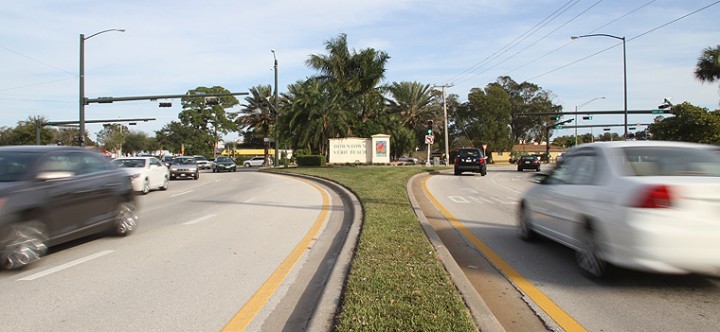
VERO BEACH — Now that an $81,000 study on whether to narrow the so-called Twin Pairs has concluded that doing so is feasible, advocates of the plan are envisioning hundreds of pedestrians out and about, visiting shops that line west-bound 20th Street and east-bound 19th Place, bringing a vibrant Vero downtown to life.
Visiting what shops?
The old saying “build it and they will come” is being revamped by advocates of the road-narrowing plan selling their vision that the only thing keeping Vero from having a dynamic downtown are these two wide streets with their 45 mile-per-hour speed limit.
Their mantra is: “Provide a calmer Route 60 and they will come.”
But anyone who has walked the sidewalks of these thoroughfares – one heading west, the other east – past closed, squat buildings and dirty store fronts – has to ask: How does spending close to $1 million or more squeezing down Route 60 into two-lane streets, reducing the speed limit to 35 miles per hour, and turning existing lanes into parking spots, suddenly make Vero’s old downtown a destination?
Walking along 20th Street in the downtown area, where the traffic heads west, you pass a funeral home parking lot for 50 cars, a convenience store, a coin laundry and a small deli.
Or, you can cross the street to a Mexican restaurant, another convenience store, a closed cleaners and a vet office, all with parking lots.
Then, there’s a flower shop, an office building and an outlet for artificial limbs.
Walking along 19th Place where cars head east, you pass parking lots and office buildings, a tire store, a gallery, a dance studio and some great old houses in a sad state of disrepair.
Hard to speculate on what they are being used for today.
We are talking about fewer than a dozen retail stores – including retail stores sitting on corners where there is abundant parking on the side-street – in a 16-block area along Route 60.
Hardly “hangout and wander around” territory that just needs a little help to bring it to life.
Granted, on the side streets, and particularly on 14th Avenue, there are a half dozen good restaurants and a number of galleries.
These already are thriving, particularly on the first Friday of each month (tomorrow), when they stay open and attract thousands to what has become known as the Downtown Dine and Design District.
But the Downtown Dine and Design District seemingly has not suffered as a result of the Twin Pairs.
Real estate agent Terry Torres, an advocate of slowing down traffic along eastbound and westbound Route 60, says if the public were educated, it would be clear why narrowing these streets would be a huge draw.
“Shops and offices are too close to Route 60 and that can be dangerous,” he said. “Besides, it takes too long to cross all of those lanes.”
Chris Mora, Indian River County public works director, says he won’t offer an opinion about whether it makes sense to spend hundreds of thousands of dollars – or more – to narrow the two thoroughfares. But he does know about safety: “The sidewalks are regulation, and traffic lights are set to give people almost double the time they need to get across,” he said.
Furthermore, said Mora, police and traffic control teams measure safety on Route 60 in the downtown area according to “the number of accidents, close calls and visible signs of problems.”
“The downtown area along 60 is very low in all of these areas,” he said.
But there is more to this than statistics, said Torres. “It’s the danger pedestrians perceive from all of those lanes.”
He paints a picture of happy couples walking from Pocahontas Park to a restaurant on 14th Avenue that requires crossing Route 60. But, to cross 60, he said, they have to go through the “worry and fear” of rushing across all of the lanes, which is a daunting prospect.
“Especially if they’re 75 or 80 years old,” he said, “or a young mother with a stroller, holding a toddler’s hand.”
But with a traffic light at the intersections of 14th Avenue with 20th Street and 19th Place, is there really a problem?
He points out that to narrow 60 would only cause a “40-second maximum delay for drivers and make pedestrians so much happier.”
“Isn’t that something drivers could live with?” he asks, sidestepping the estimated cost of between $680,000 to more than $1 million to narrow Route 60.
Public Works Director Mora worries about that money: “I don’t know where it will come from.”
In the meantime, while advocates of the narrowing are trying to figure that out, said Mora, traffic engineers can adjust the traffic lights to give pedestrians more time to cross Route 60 on nights when lots of pedestrians are expected downtown.
“We can do it from the main control room for no extra cost, if such a simple solution is wanted,” said Mora.



